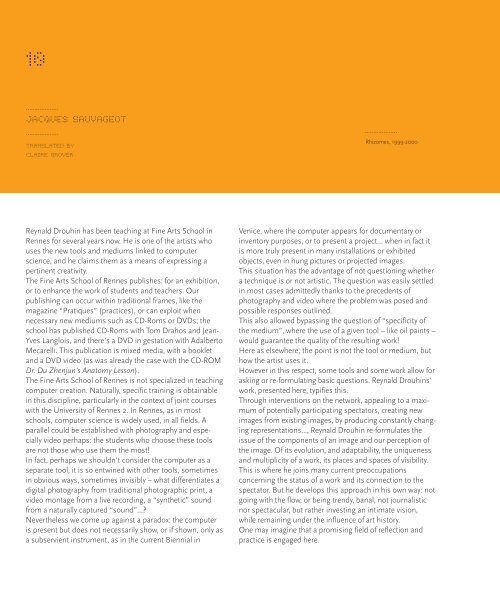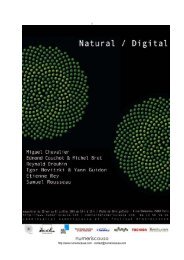Télécharger le pdf de la publication - Reynald Drouhin
Télécharger le pdf de la publication - Reynald Drouhin
Télécharger le pdf de la publication - Reynald Drouhin
You also want an ePaper? Increase the reach of your titles
YUMPU automatically turns print PDFs into web optimized ePapers that Google loves.
10<br />
...................<br />
JACQUES SAUVAGEOT<br />
...................<br />
TRANSLATED BY<br />
CLAIRE GROVER<br />
<strong>Reynald</strong> <strong>Drouhin</strong> has been teaching at Fine Arts School in<br />
Rennes for several years now. He is one of the artists who<br />
uses the new tools and mediums linked to computer<br />
science, and he c<strong>la</strong>ims them as a means of expressing a<br />
pertinent creativity.<br />
The Fine Arts School of Rennes publishes: for an exhibition,<br />
or to enhance the work of stu<strong>de</strong>nts and teachers. Our<br />
publishing can occur within traditional frames, like the<br />
magazine “Pratiques” (practices), or can exploit when<br />
necessary new mediums such as CD-Roms or DVDs; the<br />
school has published CD-Roms with Tom Drahos and Jean-<br />
Yves Langlois, and there’s a DVD in gestation with Adalberto<br />
Mecarelli. This <strong>publication</strong> is mixed media, with a book<strong>le</strong>t<br />
and a DVD vi<strong>de</strong>o (as was already the case with the CD-ROM<br />
Dr. Du Zhenjun’s Anatomy Lesson).<br />
The Fine Arts School of Rennes is not specialized in teaching<br />
computer creation. Naturally, specific training is obtainab<strong>le</strong><br />
in this discipline, particu<strong>la</strong>rly in the context of joint courses<br />
with the University of Rennes 2. In Rennes, as in most<br />
schools, computer science is wi<strong>de</strong>ly used, in all fields. A<br />
paral<strong>le</strong>l could be established with photography and especially<br />
vi<strong>de</strong>o perhaps: the stu<strong>de</strong>nts who choose these tools<br />
are not those who use them the most!<br />
In fact, perhaps we shouldn’t consi<strong>de</strong>r the computer as a<br />
separate tool, it is so entwined with other tools, sometimes<br />
in obvious ways, sometimes invisibly – what differentiates a<br />
digital photography from traditional photographic print, a<br />
vi<strong>de</strong>o montage from a live recording, a “synthetic” sound<br />
from a naturally captured “sound”...?<br />
Neverthe<strong>le</strong>ss we come up against a paradox: the computer<br />
is present but does not necessarily show, or if shown, only as<br />
a subservient instrument, as in the current Biennial in<br />
...................<br />
Rhizomes, 1999-2000<br />
Venice, where the computer appears for documentary or<br />
inventory purposes, or to present a project... when in fact it<br />
is more truly present in many instal<strong>la</strong>tions or exhibited<br />
objects, even in hung pictures or projected images.<br />
This situation has the advantage of not questioning whether<br />
a technique is or not artistic. The question was easily sett<strong>le</strong>d<br />
in most cases admittedly thanks to the prece<strong>de</strong>nts of<br />
photography and vi<strong>de</strong>o where the prob<strong>le</strong>m was posed and<br />
possib<strong>le</strong> responses outlined.<br />
This also allowed bypassing the question of “specificity of<br />
the medium”, where the use of a given tool – like oil paints –<br />
would guarantee the quality of the resulting work!<br />
Here as elsewhere, the point is not the tool or medium, but<br />
how the artist uses it.<br />
However in this respect, some tools and some work allow for<br />
asking or re-formu<strong>la</strong>ting basic questions. <strong>Reynald</strong> <strong>Drouhin</strong>s’<br />
work, presented here, typifies this.<br />
Through interventions on the network, appealing to a maximum<br />
of potentially participating spectators, creating new<br />
images from existing images, by producing constantly changing<br />
representations..., <strong>Reynald</strong> <strong>Drouhin</strong> re-formu<strong>la</strong>tes the<br />
issue of the components of an image and our perception of<br />
the image. Of its evolution, and adaptability, the uniqueness<br />
and multiplicity of a work, its p<strong>la</strong>ces and spaces of visibility.<br />
This is where he joins many current preoccupations<br />
concerning the status of a work and its connection to the<br />
spectator. But he <strong>de</strong>velops this approach in his own way: not<br />
going with the flow, or being trendy, banal, not journalistic<br />
nor spectacu<strong>la</strong>r, but rather investing an intimate vision,<br />
whi<strong>le</strong> remaining un<strong>de</strong>r the influence of art history.<br />
One may imagine that a promising field of ref<strong>le</strong>ction and<br />
practice is engaged here.






